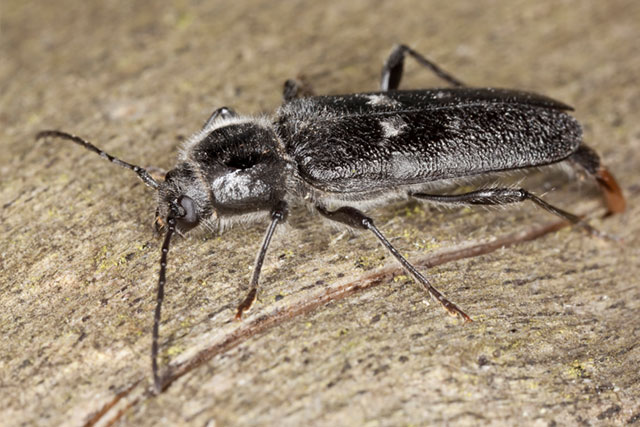Wood boring insects refer to a selection of arthropods which cause damage to wooden structures. This group of insects features a range of species of insect at different stages of their life cycles from larvae to adults.

Old house borer, house longhorn beetle
The old house borer, hylotrupes bajulus, is native to Europe but has been spread to many areas worldwide through the trade in timber and wood products. It is a pest of seasoned sapwood of softwood timber. It is more often found in new homes, infesting younger timber, rather than timber in old buildings. The life cycle takes up to 10 years, depending on environmental conditions and the nutrient content of the wood, which decreases with age.
Infestation in homes is caused mainly by using timber already containing the eggs or larvae. They feed on the wood, mainly near the surface, until maturing into the adults. The larvae are larger than many wood boring larvae, about one tenth of an inch long and they cut larger exit holes 2-3 inches in diameter.
Anoplophora longhorn beetles (FERA)
The Asian longhorn beetle (anoplophora glabripennis) and citrus longhorn beetle (anoplophora chinensis) are native to East Asia but have been introduced to other areas of the world, most significantly Europe and North America. The Asian longhorn beetle is a pest of hardwood trees in roadside plantings and plantations in China and has now become a pest in Europe and the US. In the US it tends to attack Acer species. The citrus longhorn beetle is a pest of over 100 species of tree and shrub.
In the UK and the US the early discoveries of the beetles were related to plants imported from China and Korea. Both species are listed in the EU Plant Health Directive, while in the US the Department of Agriculture and the Forest Service ask for notification if the Asian longhorn beetle is spotted.
The adult female of the Asian longhorn beetle chews a small pit in the bark to lay each egg. The larvae feed within the vascular layers of the tree: the citrus longhorn in the lower part of the tree and the Asian longhorn in the upper trunk and branches. The adults make a round exit hole about 4 inches in diameter.
Wharf borer
The wharf borer, narcerdes melanura, has been found in many temperate countries including the UK, Australia, New Zealand, France, Japan and all states of the US except Florida. The beetle is found where there is moist decaying wood, such as in docks, harbors, jetties and along rivers and coastal areas. The females lay eggs on the rotten timber and the eggs hatch in 5-11 days. The larvae burrow less than a half inch below the surface, then tunnel into the wood to feed. The larval stage can last from two months to two years, depending on conditions. The adults do not feed, living only a few days to mate and find a new site to lay eggs.
The wharf borer is a ‘secondary pest’ as it feeds on already rotten timber, but its tunnels can further weaken the timbers.
PortLand Furniture

 Tiếng Việt
Tiếng Việt





